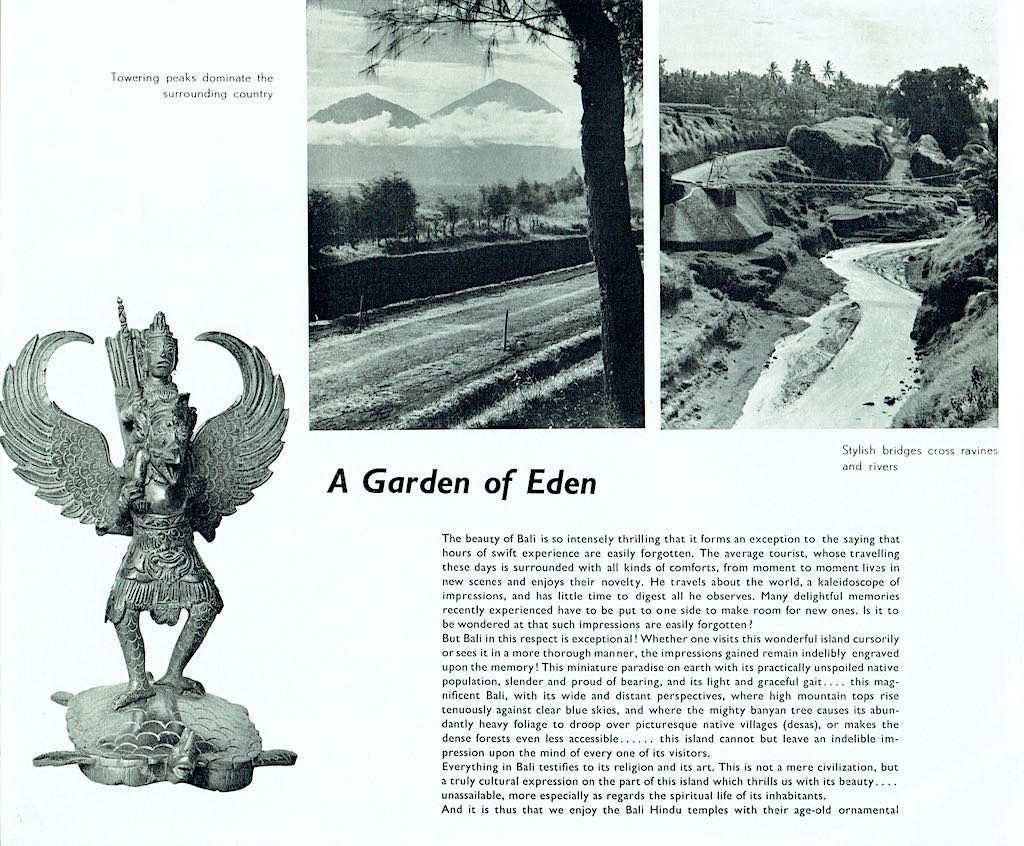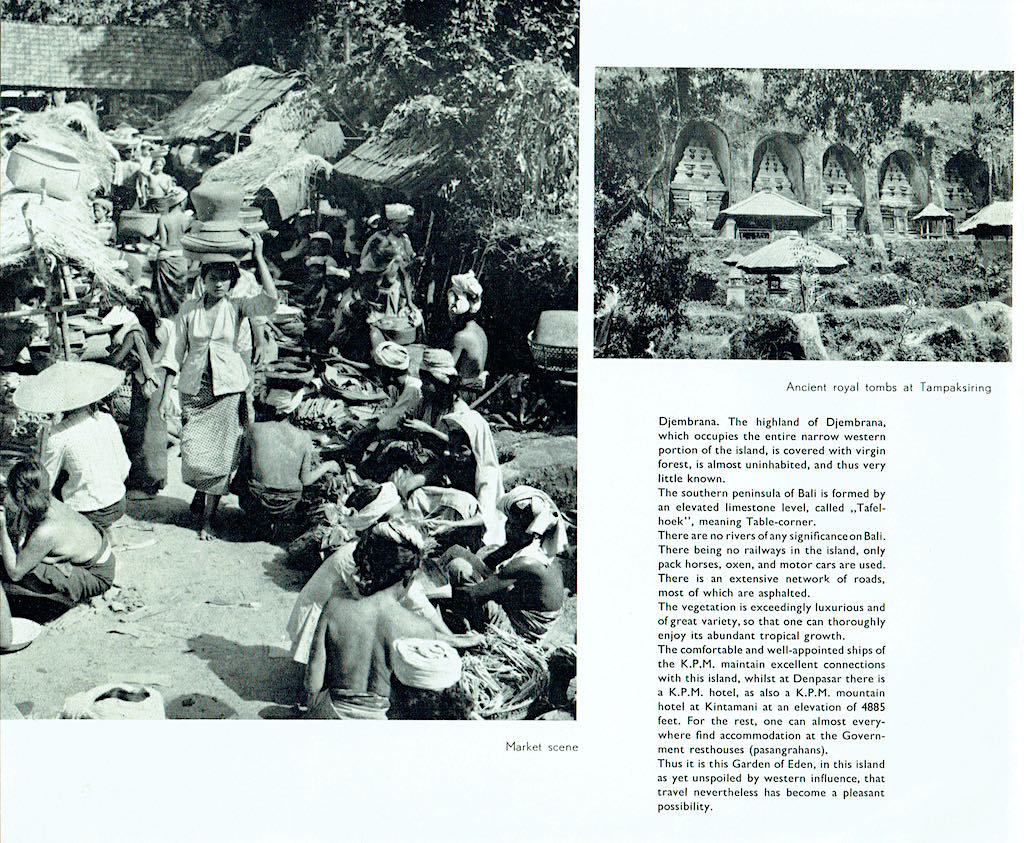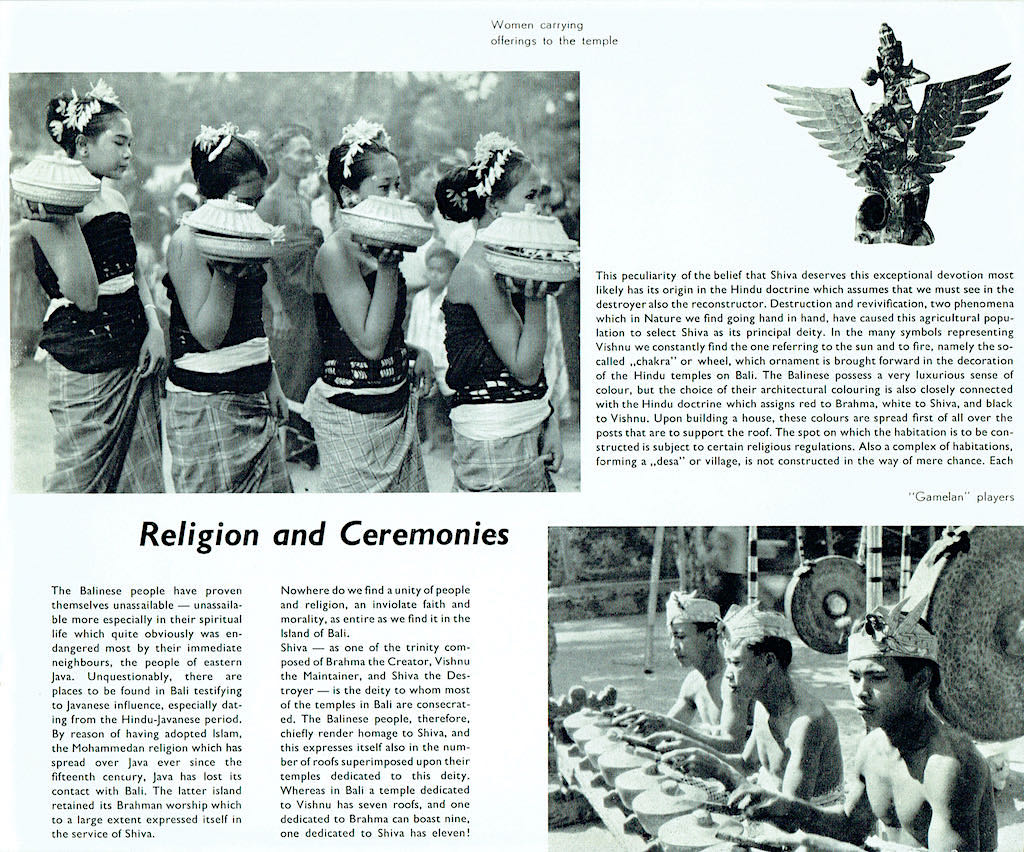This rare travel brochure was published in 1938 by the Koninklijke Paketvaart-Maatschappij (KPM). The booklet with two drawings by Willem Hofker (on the cover and on the last page) portrays Bali as a tourist paradise and an unspoiled Garden of Eden. Read a summary of the text below.
The beauty of Bali is so intensely thrilling that it forms an exception to the saying that hours of swift experience are easily forgotten. The average tourist, whose travelling these days is surrounded with all kinds of comforts, from moment to moment lives in new scenes and enjoys their novelty. He travels about the world, a kaleidoscope of impressions, and has little time to digest all he observes. Many delightful memories recently experienced have to be put to one side to make room for new ones. Is it to be wondered at that such impressions are easily forgotten?
But Bali in this respect is exceptional! Whether one visits this wonderful island cursorily or sees it in a more thorough manner, the impressions gained remain indelibly engraved upon the memory! This miniature paradise on earth with its practically unspoiled native population, slender and proud of bearing, and its light and graceful gait … this magnificent Bali, with its wide and distant perspectives, where high mountain tops rise tenuously against clear blue skies, and where the mighty banyan tree causes its abundantly heavy foliage to droop over picturesque native villages (desas), or make the dense forests even less accessible … this island cannot but leave an indelible impression upon the mind of every one of its visitors.
Everything in Bali testifies to its religion and its art. This is not a mere civilization, but a truly cultural expression on the part of this island which thrills us with its beauty … unassailable, more especially as regards the spiritual life of its inhabitants.
And it is thus that we enjoy the Bali Hindu temples with their age-gold ornamental symbols in artful decoration — the Bali habitations, usually made of clay and covered with straw or palm fibre, and their handsomely formalized gates or entries — the colorful ornaments and luxurious palaces of their princes.
The most noteworthy monuments in a Balinese village are the “puri” (the residence of the local princelet) with its high gates, its handsome open-work walls and “balé’s” (a kind of scenic terrace with turrets), the “kul-kul” (bell-towers) whence the people are called to assemble at a feast or for some solemn celebration, the “wantilan” (structures in which the cock-fights are held), the temples and the “pasars” (markets) where there always are interested and interesting crowds.
The craftsmanship of the Balinese endues him with a sense of order and this is reflected in the mighty organization prevailing all over the island. A Bali famer works on the grounds released to his village or to him by his prince who in his turn holds the soil in tenure from the deity.
Balinese arts and crafts
Also Balinese art is highly developed. This is clearly visible from the refined and artistic workmanship as seen on temples and gates, from the ingeniously arranged offerings, from the masks, the sarongs, the slendangs; from the beautiful headgear worn during the dance, and from the highly decorated funeral towers and cremation animals.
The products resulting from the artistic sense of the Balinese are now obtainable also for tourists. Usually they are objects used by priests in their ritual prayers, such as prayer bells, vessels having held consecrated water, and similar articles; besides these, also things of daily and household use, as for example sirihplatters, or drinking vessels.
One of the most interesting products of Balinese art is the mask. There are comic and tragic masks, monter masks and horrible ones all according to what the actor may have to use in the course of his performance.
Coconut shells are cut into all kind of shapes, whilst patterns, to be used for various purposes, are carefully worked with filigree figures and the cut out. And should one be fortunate enough actually to see an artist wood-worker busy with his tools, it will be a pleasure to notice the skill het exhibits in his work.
Also numerous images are cut in wood. Then there are the “lontars”, or ancient scriptures which are made of palm leaves and whose pages are inscribed with strange Balinese signs and representations that depict entire legends.

The center of gold and silver is Klungkung. Also to this branch of artistic endeavour the Balinese pay a good deal of attention; for it is connected with the belief of the Balinese in the magical properties of metals.
A very important industrial art is the making of krisses which can be purchased in may varieties and at various prices, to suit each purse. Many of these are highly chiselled and most artistically cut, with blades of many shapes; there are some inlaid with gold and silver.
Kains, sarongs and slendangs, sometimes heavily worked with silver and gold thread, are woven in many varieties by the women of Bali themselves, and painted by them. The more precious kinds are worn at dance performances and temple gatherings. The art of weaving is still greatly flourishing and fully deserves the attention of each visitor to the island.Even though one may not have the artistic instinct to any extent, nevertheless the Balinese impresses and fascinates, and we cannot but admire the enchantingly beautiful products of his art.
Travel and stay with K.P.M.
The comfortable and well-appointed ships of the K.P.M. maintain excellent connections with this island, whilst at Denpasar there is a K.P.M. hotel, as also a K.P.M. mountain hotel at Kintamani at an elevation of 4885 feet. For the rest, one can almost everywhere find accommodation at the Government resthouses (pasangrahans).
Thus it is this Garden of Eden, in this island as yet unspoiled by western influence, that travel nevertheless has become a pleasant possibility.


















